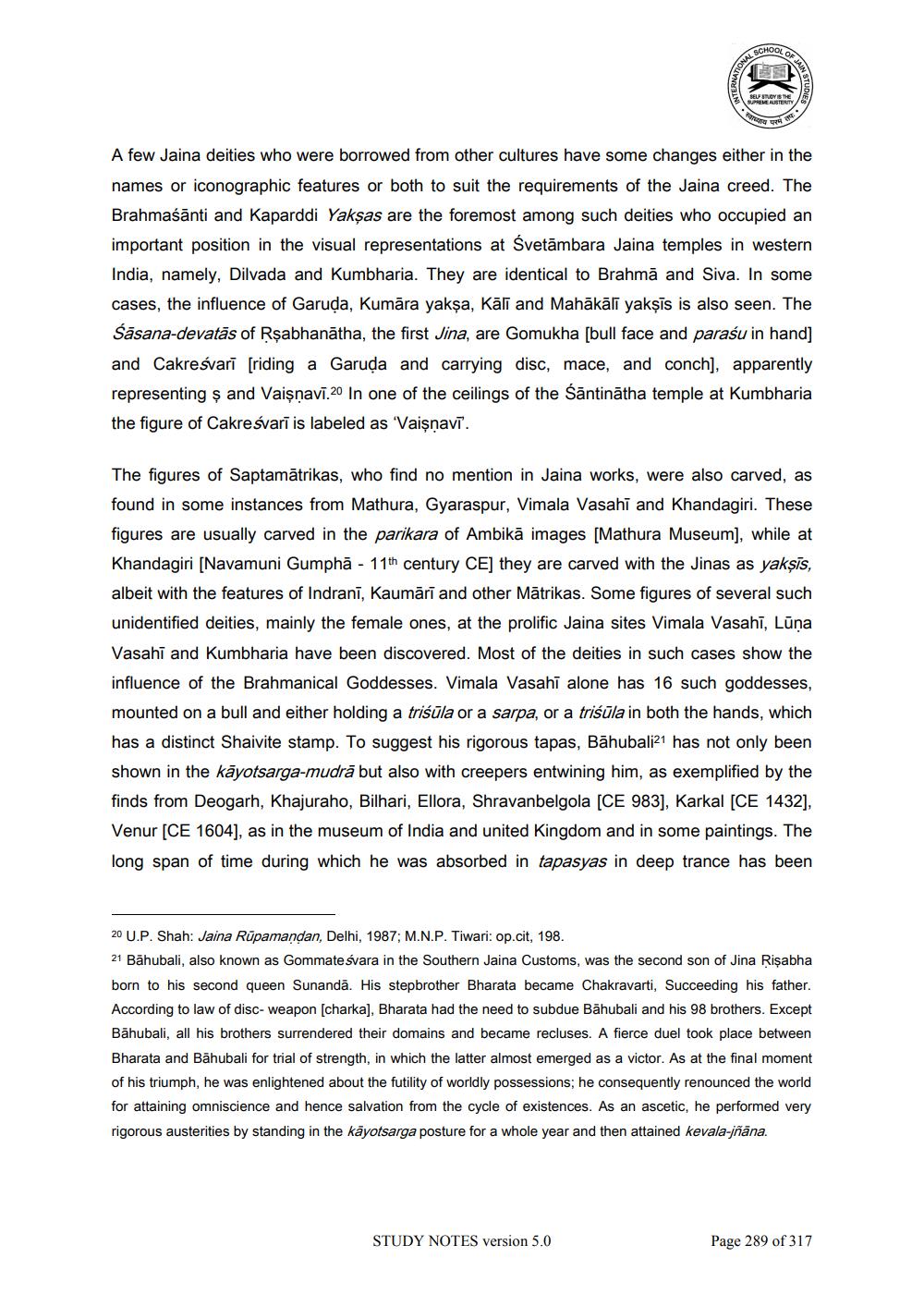________________
INTERNATION
SCHOOL
OF
STUDY NOTES version 5.0
AN STUDIES
SELF STUDY IS THE SUPREME AUSTERITY
स्वाध्याय
A few Jaina deities who were borrowed from other cultures have some changes either in the names or iconographic features or both to suit the requirements of the Jaina creed. The Brahmaśānti and Kaparddi Yakṣas are the foremost among such deities who occupied an important position in the visual representations at Svetāmbara Jaina temples in western India, namely, Dilvada and Kumbharia. They are identical to Brahma and Siva. In some cases, the influence of Garuda, Kumāra yakṣa, Kālī and Mahākāli yakṣis is also seen. The Šāsana-devatās of Ṛṣabhanatha, the first Jina, are Gomukha [bull face and parasu in hand] and Cakresvari [riding a Garuda and carrying disc, mace, and conch], apparently representing $ and Vaisnavi.20 In one of the ceilings of the Santinatha temple at Kumbharia the figure of Cakreśvarī is labeled as 'Vaiṣṇavi'.
The figures of Saptamātrikas, who find no mention in Jaina works, were also carved, as found in some instances from Mathura, Gyaraspur, Vimala Vasahi and Khandagiri. These figures are usually carved in the parikara of Ambika images [Mathura Museum], while at Khandagiri [Navamuni Gumphā - 11th century CE] they are carved with the Jinas as yakṣis, albeit with the features of Indrani, Kaumārī and other Matrikas. Some figures of several such unidentified deities, mainly the female ones, at the prolific Jaina sites Vimala Vasahī, Lūņa Vasahi and Kumbharia have been discovered. Most of the deities in such cases show the influence of the Brahmanical Goddesses. Vimala Vasahī alone has 16 such goddesses, mounted on a bull and either holding a triśula or a sarpa, or a trisula in both the hands, which has a distinct Shaivite stamp. To suggest his rigorous tapas, Bahubali21 has not only been shown in the kayotsarga-mudrā but also with creepers entwining him, as exemplified by the finds from Deogarh, Khajuraho, Bilhari, Ellora, Shravanbelgola [CE 983], Karkal [CE 1432]. Venur [CE 1604], as in the museum of India and united Kingdom and in some paintings. The long span of time during which he was absorbed in tapasyas in deep trance has been
20 U.P. Shah: Jaina Rūpamandan, Delhi, 1987; M.N.P. Tiwari: op.cit, 198.
21 Bahubali, also known as Gommatesvara in the Southern Jaina Customs, was the second son of Jina Risabha born to his second queen Sunanda. His stepbrother Bharata became Chakravarti, Succeeding his father. According to law of disc- weapon [charka], Bharata had the need to subdue Bahubali and his 98 brothers. Except Bahubali, all his brothers surrendered their domains and became recluses. A fierce duel took place between Bharata and Bahubali for trial of strength, in which the latter almost emerged as a victor. As at the final moment of his triumph, he was enlightened about the futility of worldly possessions; he consequently renounced the world for attaining omniscience and hence salvation from the cycle of existences. As an ascetic, he performed very rigorous austerities by standing in the käyotsarga posture for a whole year and then attained kevala-jñāna.
Page 289 of 317




